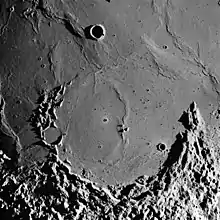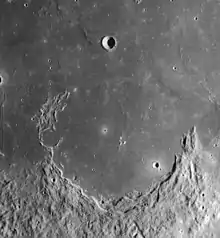Letronne (crater)
Letronne is the lava-flooded remnant of a lunar impact crater. It was named after French archaeologist Jean-Antoine Letronne.[1] The northern part of the rim is completely missing, and opens into the Oceanus Procellarum, forming a bay along the southwestern shore. The formation is located to the northwest of the large crater Gassendi.To the west-southwest is the flooded crater Billy, and north-northwest lies the smaller Flamsteed.
 | |
| Coordinates | 10.6°S 42.4°W |
|---|---|
| Diameter | 120 km |
| Depth | 1.0 km |
| Colongitude | 42° at sunrise |
| Eponym | Jean-Antoine Letronne |

The surviving rim of Letronne is now little more than a semi-circular series of ridges. The flooded, broken rim of Winthrop overlies the western wall. The rim is the most intact along the eastern stretch, forming a mountainous promontory into the mare. A small cluster of central rises lie at the midpoint of the crater. The wrinkle ridge Dorsa Rubey traverses the floor from north to south,[2] and outlines a portion of the missing rim. The crater floor is otherwise nearly smooth and relatively free of craterlets, with the exception of Letronne B near the southeast rim.
Satellite craters
By convention these features are identified on lunar maps by placing the letter on the side of the crater midpoint that is closest to Letronne.
| Letronne | Latitude | Longitude | Diameter |
|---|---|---|---|
| A | 12.1° S | 39.1° W | 7 km |
| B | 11.2° S | 41.2° W | 5 km |
| C | 10.7° S | 38.5° W | 4 km |
| F | 9.2° S | 46.1° W | 8 km |
| G | 12.7° S | 46.5° W | 10 km |
| H | 12.6° S | 46.0° W | 4 km |
| K | 14.5° S | 43.6° W | 5 km |
| L | 14.3° S | 44.3° W | 5 km |
| M | 12.0° S | 44.1° W | 3 km |
| N | 12.3° S | 39.8° W | 4 km |
| T | 12.5° S | 42.6° W | 3 km |
The following craters have been renamed by the IAU.
References
- "Letronne (crater)". Gazetteer of Planetary Nomenclature. USGS Astrogeology Research Program.
- Map quadrangle LAC-75, Gazetteer of Planetary Nomenclature. USGS Astrogeology Research Program
- Andersson, L. E.; Whitaker, E. A. (1982). NASA Catalogue of Lunar Nomenclature. NASA RP-1097.CS1 maint: ref=harv (link)
- Bussey, B.; Spudis, P. (2004). The Clementine Atlas of the Moon. New York: Cambridge University Press. ISBN 978-0-521-81528-4.CS1 maint: ref=harv (link)
- Cocks, Elijah E.; Cocks, Josiah C. (1995). Who's Who on the Moon: A Biographical Dictionary of Lunar Nomenclature. Tudor Publishers. ISBN 978-0-936389-27-1.CS1 maint: ref=harv (link)
- McDowell, Jonathan (July 15, 2007). "Lunar Nomenclature". Jonathan's Space Report. Retrieved 2007-10-24.CS1 maint: ref=harv (link)
- Menzel, D. H.; Minnaert, M.; Levin, B.; Dollfus, A.; Bell, B. (1971). "Report on Lunar Nomenclature by the Working Group of Commission 17 of the IAU". Space Science Reviews. 12 (2): 136–186. Bibcode:1971SSRv...12..136M. doi:10.1007/BF00171763.CS1 maint: ref=harv (link)
- Moore, Patrick (2001). On the Moon. Sterling Publishing Co. ISBN 978-0-304-35469-6.CS1 maint: ref=harv (link)
- Price, Fred W. (1988). The Moon Observer's Handbook. Cambridge University Press. ISBN 978-0-521-33500-3.CS1 maint: ref=harv (link)
- Rükl, Antonín (1990). Atlas of the Moon. Kalmbach Books. ISBN 978-0-913135-17-4.CS1 maint: ref=harv (link)
- Webb, Rev. T. W. (1962). Celestial Objects for Common Telescopes (6th revised ed.). Dover. ISBN 978-0-486-20917-3.CS1 maint: ref=harv (link)
- Whitaker, Ewen A. (1999). Mapping and Naming the Moon. Cambridge University Press. ISBN 978-0-521-62248-6.CS1 maint: ref=harv (link)
- Wlasuk, Peter T. (2000). Observing the Moon. Springer. ISBN 978-1-85233-193-1.CS1 maint: ref=harv (link)
| Wikimedia Commons has media related to Letronne (crater). |